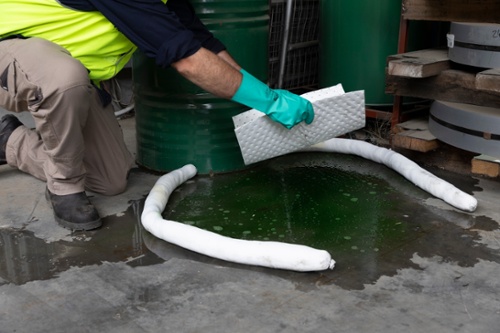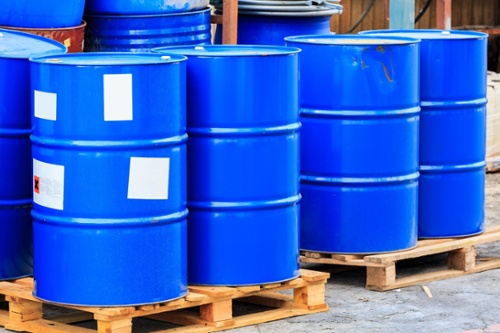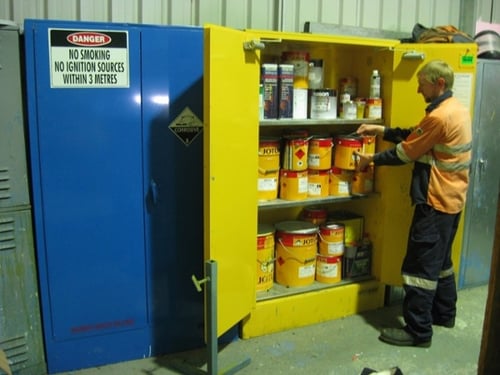When working with dangerous goods, it’s crucial that staff, supervisors, contractors and other personnel are aware of the hazards associated with the chemicals. However, when it comes to busy workplaces that have multiple staff handling a variety of hazardous chemicals, seemingly simple mistakes can be made which can lead to bigger problems down the line. In this post, we’ll be looking at risk reduction by focusing on raising awareness of chemical hazards in your workplace. By helping your staff — as well as other people onsite — better understand the hazards associated with your chemical products, you can educate and inform them of the many ways in which they can help create a safer workplace. Let’s now take a deep dive into hazardous chemical spillage and how you can avoid it happening in your organisation.
Chemical Safety
In this next section, we’ll offer an example of an everyday chemical safety incident which could occur in any workplace. We’ll then offer some suggestions on how you can reduce the likelihood and impact of an incident involving the mishandling of chemical products.
A new staff member receives a chemical shipment in the loading dock of a business. Distracted by other work tasks, the worker overlooks the Class 3 Flammable Liquids packages that have been delivered. When the packages are finally retrieved by a supervisor in the relevant department, they notice that the containers within the package have been split and are dripping flammable liquids all over the concrete floor.
Understanding the hazards associated with your chemicals is the first consideration for risk reduction. But making sure that all staff understand these hazards involves a systematic approach to risk management.
REMEMBER: Flammable liquids are Class 3 dangerous goods that pose a range of risks to the businesses that carry them. In a case like this, where the spill is not promptly identified, the work area could have been at risk of fire or explosion if an ignition source was present. Spills also pose the risk of physical injury, with unsuspecting staff slipping in the spillage.
In this circumstance, there are many factors at play, including:
- The inexperience of the staff member
- An overloaded work schedule
- Lack of care when it comes to handling packages
- No strict procedures for managing chemical deliveries
- An unawareness of the chemical hazards associated with the delivery
- Packages not immediately taken to the appropriate storage
Identifying Risks With Spillage
Because these packages are left on the dock (when they should have been placed in storage) — they are also exposed to heat and impact damage. They may also be close to other hazardous substances that are handled or transferred through the location. A situation such as this could lead to a multitude of issues far greater than a chemical spill.
These risks could include:
- Asphyxiation from hazardous vapours
- Chemical burns from staff unknowingly touching the liquid
- Fire or explosion if an ignition source is present
- Chemical reactions caused by incompatible substances meeting
- Environmental damage if the spill leaks into soil or waterways
Let’s look at some simple strategies that you can implement to improve the chemical hazard awareness in your own workplace.
Adequate Training For Staff
Every staff member at your site, including contractors, who handle hazardous chemicals should undergo a training program so they can work safely in that environment.
/how%20to%20assess%20chemical%20hazards%20in%20the%20workplace-600x300.jpg?width=500&name=how%20to%20assess%20chemical%20hazards%20in%20the%20workplace-600x300.jpg)
Any staff or contractors who handle or store hazardous chemicals shouuld receive adequate chemical safety training.
If you’re familiar with our blogs, you’ll already know that we strongly recommend the development of a good chemical safety training program. This doesn’t have to be a drawn out series of training sessions; in fact, chemical training can be a mixture of in person training sessions and online models.
Training (and remedial training) should include, as a minimimum:
- The hazards associated with the chemical product
- Understanding how to read Safety Data Sheets, dangerous goods signage, hazard signage and other chemical labelling and placarding
- Appropriate isolation and engineering controls for the product
- Dangerous goods segregation protocols to reduce chemical reactivity incidents
- How to use PPE, breathing apparatus and other controls to reduce health hazards
- Where to locate the spill kit and how to use it
- How to deal with an emergency situation, such as a major spill
- Where to locate eyewash and safety showers for emergency decontamination

Developing an effective spill response is a key consideration for reducing risk in delivery, handling and storage areas.
Maintaining A Fair Roster
While staffing issues may be a major factor for organisations in the present climate, it’s crucial that staff that are handling any type of dangerous goods or hazardous chemicals have enough time to be able to complete their tasks in a safe and compliant manner.
When staff are furloughed, sick or called to man other departments, it puts real pressure on the existing staff members who are left to manage their work area. While these circumstances are often out of our control, it’s important for supervisors and management to maintain extra vigilance when there are staff shortages in these areas.
Worker safety (and therefore, the safety of the organisation as a whole) is affected by the time constraints and pressure placed on team members. If you’re facing similar issues in your department, make sure that you are aware of the staff shortages and do everything possible to lighten the load of the workers who are handling these hazardous chemicals.
Calling in inducted temporary staff, reshuffling rosters or adding extra supervision to these areas can immediately reduce the pressure placed on staff — and decrease the likelihood of shortcuts being taken due to time constraints.
Work With Your Supply Chain
How you manage the supply chain is a crucial factor in maintaining chemical compliance and safely.
When chemicals arrive at your site, they should be checked by the person receiving the delivery to determine the type and dangerous goods class of chemical. Packages should then be inspected to ensure that there are no chemical leaks or other signs of damage.

Don't accept hazardous chemical packages that show signs of spillage, dents or damage.
Work with your suppliers to ensure that reasonable levels of stock are maintained at your site. Try to avoid, as much as it is reasonably possible, overstocking your chemical stores.
It’s safer to develop an ordering system that can meet the needs of your organisation — without the need to stockpile supplies. If this can be achieved (even in these challenging times when supply chains are constantly interrupted), it can help reduce the volume of chemicals held onsite, as well as the risks associated with the individual products.
Procedures For Chemical Deliveries
Only allowing fully trained staff to manage chemical deliveries is a great first step to reducing risk. However, you must also have a strict procedure for team members to follow once the chemical packages arrive onsite.
Providing clear, concise and easily understandable procedures lays a solid foundation for your organisation to minimise the risks associated with workplace chemical incidents.
Procedures for handling chemical deliveries may include instructions on:
- What staff are equipped to manage these deliveries
- How to receive, unload and transfer hazardous chemicals
- Hazards associated with each chemical product
- Where the appropriate storage for each class is
- How to safely transfer the chemical packages to their store
- What hazards to avoid during this delivery process
- How to clean up a chemical spill
IMPORTANT: Every Australian organisation handling dangerous goods or hazardous chemicals is required, under WHS Law, to consult with the appropriate staff when developing these procedures.
Developing A Coding System
Here at Storemasta, our Field Auditors have noted the difficulties organisations face when accepting hazardous chemical deliveries. To reduce the complicated task of receiving multiple classes of dangerous goods – each with their own specific hazards – we suggest implementing a colour coding system for your packages.
This involves the creation of a colour coding system that relates to the dangerous goods classes of chemicals that you have onsite. You may assign a colour to each class — such as Class 3 Flammable Liquids being assigned the red colour.
The colour will denote, for all staff who are handling and storing the chemical, the hazard class of the product.
Once the chemical package arrives onsite, your staff should be able to assign the package a specific colour by attaching a coloured label to the product. This label will remain on the package when it is picked up by the relevant staff, transferred through the workplace, and placed in the applicable dangerous goods storage area.
Once the chemical packaging has been taken off and safely discarded, your staff are then obliged to double-check the contents of the package to ensure that it is indeed a flammable liquid product suitable for that store.

A colour coding system for chemical packages can assist with the safe transferal of these products to the correct dangerous goods cabinet or store.
We find this simple system assists staff with the identification and transferring of hazardous chemicals to their storage areas. However, it is not a stand-alone method and should be implemented in conjunction with adequate training about chemical identification and the understanding of all chemical labels and signage.
IMPORTANT: If you choose to implement a colour coding system such as this, make sure all staff have a laminated sheet outlining the colour coding system. Also ensure that staff are appropriately trained to identify, handle and store these dangerous goods classes.
Transferring Chemicals Safely
Implementing a safe chemical transferal system is an important part of keeping your workplace incident-free. There are many pieces of equipment on the market which can help your workers transfer chemical packages without resulting in human harm (such as back problems), spillage or other hazards.
Options may include the use of bunded drum dollies, gas bottle trollies or other types of transfer equipment.
Also keep in mind that any lifting devices, such as forklifts, should be regularly maintained and monitored to ensure that they are operating smoothly and safely. This will reduce the likelihood of the equipment jolting or stalling during use — which could result in damaged chemical packages.
Compliant Storage
While this is the last stage is the chemical delivery process, it’s a key consideration for any business which has ordered any quantity of hazardous chemicals or dangerous goods.
Choosing compliant storage, such as an indoor flammable liquids storage cabinet, will help your business reduce the risk of uncontrolled spillage and human harm. Your chemical deliveries should always be assigned a specific destination, such as an indoor cabinet or outdoor store which is specifically designed and constructed for that chemical product. The properties of your chemical will be specific to the chemical supplier or brand that you use. Therefore, by referring to the Safety Data Sheet, you will be able to determine the correct method of storage.
Also keep in mind, when loading your cabinet or store, to discard any packaging (such as cardboard boxes) and take all combustibles away from the site. You should refer to the operating procedures for your flammable liquids store (to find out more about this topic, see our helpful article), so your staff know how to properly stack, load, clean and maintain your cabinet.
Reducing Risk With Onsite Deliveries
Do you need some assistance with chemical risk reduction in your loading dock, chemical handling or storage areas? How To Manage The Risk Of Hazardous Chemicals In The Workplace will help you reduce the likelihood of spillage through the implementation of our risk control methodology. Our guide also includes a handy risk management matrix template, so you can determine your pre- and post-mitigation risks. Get your free copy today by simply clicking on the image below.
Joining the team as a Dangerous Goods Storage Consultant, Melissa Hampton became Storemasta's Marketing Manager in late 2021. With extensive knowledge and experience in chemical compliance, Melissa is responsible for leading the Marketing team and helping shape their marketing strategy. In her spare time, you can find Melissa hiking, swimming and enjoying the great outdoors in beautiful north-west Tasmania.
